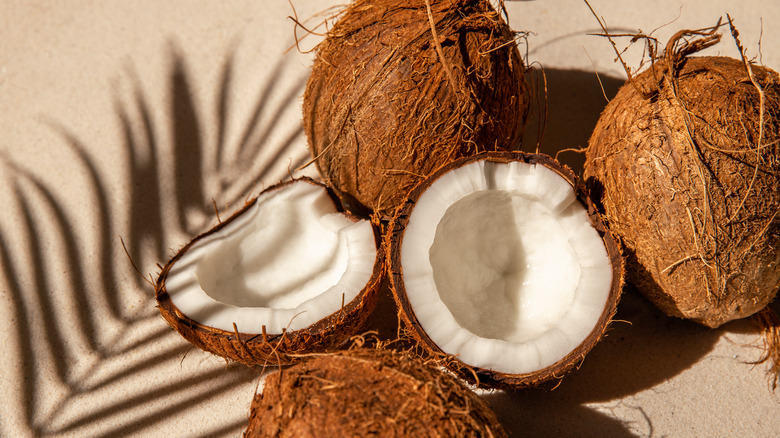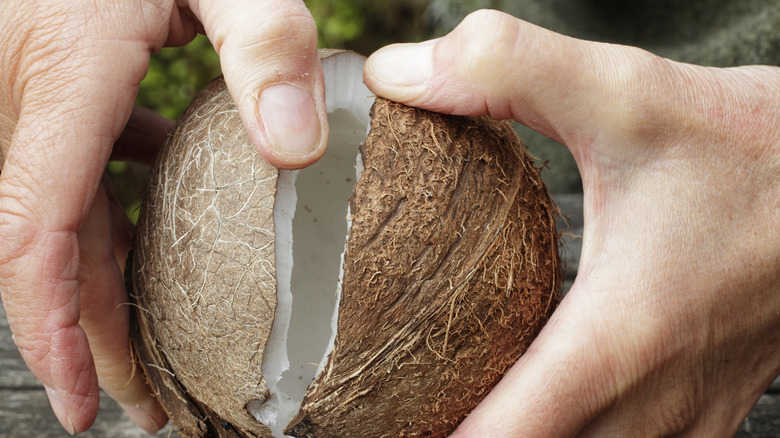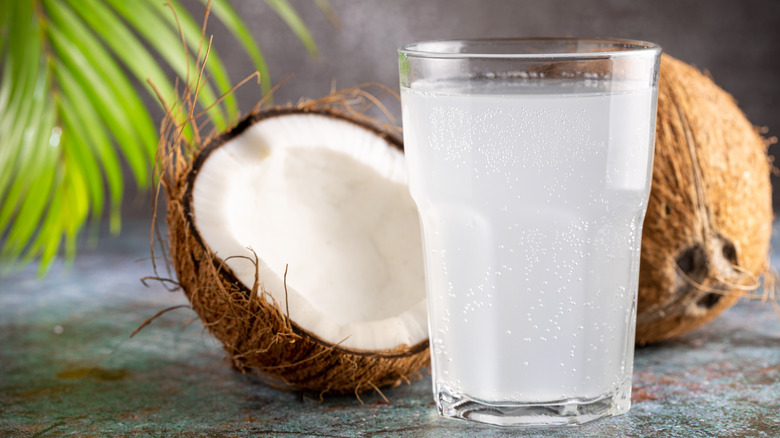The Game Changing Method For Scooping Out Fresh Coconut Meat
Despite not being a pantry staple, fresh coconuts are the star of the show in many excellent recipes. As the garnish for a coconut pie or processed into coconut milk to flavor a hearty mushroom coconut curry, there's no shortage of ways to use this drupe (not a nut) in the kitchen. But there's the (literally) problem of extracting the coconut meat from within the rock-hard shell. Here's a little tip that'll make your life infinitely easier: freeze the coconut first.
When the coconut is frozen, the meat inside solidifies into a single block. When you crack the shell open, it'll slide off the husk with a gentle tug. Not only does this preserve the coconut meat, but the shucked husk will be quite clean, too, without stringy bits of leftover coconut meat stuck on it (it'll make for a chic bowl).
Using the old-fashioned way, harvesting the coconut meat can be an extremely tedious chore. You'd have to slowly carve your way around the interior of the coconut, scooping out the fleshy bit one slice at a time. If you have a tight schedule to run, all that time hovering over the coconut could be used for a lot of other things, and that's what makes this technique such a winner. Excluding the time to freeze the coconut, you can get fresh coconut meat for whatever treat you're making in a few seconds.
Cracking open your frozen-solid coconut
First, place the coconut in the freezer, preferably overnight — you'll want the meat within to completely freeze. On the coconut-cracking day, take it out and start by taking a blunt tool, like the spine of a cleaver or a kitchen knife (there's no need for a hammer!), and smack it along the equator of the coconut as hard as you can. Rotate the coconut as you go until the shell separates cleanly in half.
Here's the best bit: Normally, this is when you'd take a paring knife and get to work scooping out the meat. But since you've frozen the coconut flesh prior, just tug on it a bit with your fingers, and it should come off (if it's a bit stuck, dig your knife's point into the intersection between the coconut meat and the shell and pry it off).
So far, we've skipped one step that's crucial when cracking an unfrozen coconut, which is draining the coconut water inside. No worries, because the water is frozen, it won't drip and make a mess of your countertop when you crack the shell. And luckily for coconut water mojito enjoyers out there, the frozen coconut water is totally salvageable.
Two ways to save the coconut water
The coconut water isn't gone; it's just frozen inside the coconut. In fact, when you crack it open, the sweet juice should also fall out of the two cracked halves as flakes of clear-looking "ice." It's a bit makeshift, but you can gather all these flakes (there should be more stuck on the coconut meat, just scrape them off with a spoon) and put them into a bowl to defrost. If any coconut debris made it inside the bowl, just skim them off.
A better idea, though, is to extract the water before you put the coconut into the freezer. Find the largest "eye" of the coconut — the biggest among the three circles on top of the coconut — and pierce it with the tip of your knife until you have a clean puncture through to the coconut's core. Now, just get an empty glass and upturn the coconut so that all the water flows out. Once it's emptied, save the water and freeze the rest of the coconut for cracking later.
The husk, the meat, now the water — all three important bits of the coconut can be saved and easily harvested with this trick. Unless you're short on time, why bother using any other method when just freezing the drupe will make coconuts easier to work with in every way?


